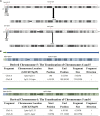Combination of trio-based whole exome sequencing and optical genome mapping reveals a cryptic balanced translocation that causes unbalanced chromosomal rearrangements in a family with multiple anomalies
- PMID: 37745854
- PMCID: PMC10512417
- DOI: 10.3389/fgene.2023.1248544
Combination of trio-based whole exome sequencing and optical genome mapping reveals a cryptic balanced translocation that causes unbalanced chromosomal rearrangements in a family with multiple anomalies
Abstract
Background: Balanced translocation (BT) carriers can produce imbalanced gametes and experience recurrent spontaneous abortions (RSAs) and even give birth to a child with complex chromosomal disorders. Here, we report a cryptic BT, t(5; 6) (p15.31; p25.1), in the proband's grandmother, which caused unbalanced chromosomal rearrangements and various anomalies in the two subsequent generations. We also provide a thorough overview of the application of optical genome mapping (OGM) to identify chromosomal structural variants (SVs). Methods: Trio-based whole exome sequencing (Trio-WES) was conducted to explore the genetic basis of the phenotype of the proband and her mother. High-resolution karyotype analysis and OGM detection were performed on the proband's grandparents to trace the origin of the unbalanced rearrangements between chromosomes 5 and 6. A PubMed search was conducted with the following keywords: "OGM" and "SVs." Then, relevant studies were collected and systematically reviewed. Results: The proband and her mother presented with various anomalies, whereas the grandmother was healthy but had a history of four abnormal pregnancies. Trio-WES revealed a heterozygous duplication on the terminal region of chromosome 5p and a heterozygous deletion on the proximal end of chromosome 6p in the proband and her mother. High-resolution karyotype analysis revealed no aberrant karyotypes in either grandparent, whereas OGM detection revealed a cryptic BT, t(5; 6)(p15.31; p25.1), in the proband's grandmother. An overwhelming majority of research publications have verified the clinical utility of OGM in detecting SVs. Conclusion: The results of this study revealed that the unbalanced chromosomal rearrangements and many anomalies observed in multiple members of the family were attributable to the cryptic BT carried by the proband's grandmother. This study supports that OGM has a unique advantage for detecting cryptic BTs, and can be used as a first-tier genetic test for the etiological diagnosis of infertility, RSAs, and other complex genetic disorders.
Keywords: case report; cryptic balanced translocation; multiple anomalies; optical genome mapping; unbalanced chromosomal rearrangements.
Copyright © 2023 Xie, Xue, Zhang, Zhou, Yu, Li and Li.
Conflict of interest statement
The authors declare that the research was conducted in the absence of any commercial or financial relationships that could be construed as a potential conflict of interest.
Figures



Similar articles
-
Detection of cryptic balanced chromosomal rearrangements using high-resolution optical genome mapping.J Med Genet. 2023 Mar;60(3):274-284. doi: 10.1136/jmedgenet-2022-108553. Epub 2022 Jun 16. J Med Genet. 2023. PMID: 35710108
-
Analysis of chromosomal structural variations in patients with recurrent spontaneous abortion using optical genome mapping.Front Genet. 2023 Sep 4;14:1248755. doi: 10.3389/fgene.2023.1248755. eCollection 2023. Front Genet. 2023. PMID: 37732322 Free PMC article.
-
Detection of complex chromosome rearrangements using optical genome mapping.Gene. 2023 Oct 30;884:147688. doi: 10.1016/j.gene.2023.147688. Epub 2023 Aug 3. Gene. 2023. PMID: 37543218
-
Historical and Clinical Perspectives on Chromosomal Translocations.Adv Exp Med Biol. 2018;1044:1-14. doi: 10.1007/978-981-13-0593-1_1. Adv Exp Med Biol. 2018. PMID: 29956287 Review.
-
[A family of hereditary protein S deficiency with the onset of pulmonary embolism and literature review].Zhonghua Er Ke Za Zhi. 2022 Feb 2;60(2):134-138. doi: 10.3760/cma.j.cn112140-20210915-00797. Zhonghua Er Ke Za Zhi. 2022. PMID: 35090231 Review. Chinese.
Cited by
-
Optical Genome Mapping Identifies a Novel Unbalanced Translocation Between Chromosomes 4q and 6q Leading to Feeding Difficulties and Hypotonia in a Neonate: A Case Report.Appl Clin Genet. 2024 May 27;17:63-69. doi: 10.2147/TACG.S465244. eCollection 2024. Appl Clin Genet. 2024. PMID: 38828444 Free PMC article.
References
Publication types
Grants and funding
LinkOut - more resources
Full Text Sources

